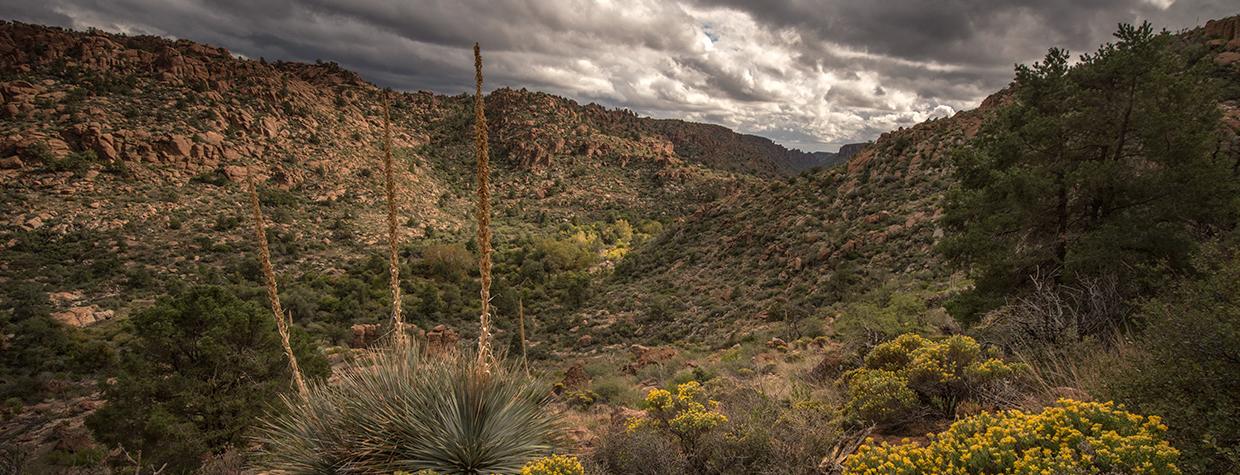Editor’s Note: Chances are, you’ve already read about Oak Flat. It’s a controversial story that’s been in the news for more than a decade. Like every story, there are at least two sides to this one. Although it’s not our job to tell you which side to support — we’ll leave that to the editorial boards of The Arizona Republic and other newspapers — it is our job to promote travel in Arizona. In fact, that’s our mission, which was mandated by the state Legislature in the early 1920s. To accomplish that mission, we do stories about the things that inspire readers to hit the road. Things like scenic landscapes, historic and cultural landmarks, and outdoor recreation. Oak Flat features all of the above. It’s a place that goes to the heart of our mission, and we’ve been featuring it for decades. One of the earliest stories was about the sacred history of the Apaches at Apache Leap — we published that piece in October 1940. Seventy-six years later, we’re writing about the sacred history and culture of the Apaches again. Why? Because they’re at the center of what’s happening at Oak Flat. As you’ll see, it’s a complicated story with many layers. Although we’ve done our best to address all of them, we have only so many pages.
When the World Was New
Part of one creation story of the Apache people goes like this:
The old world was covered by water — a flood so great it left only the top of one white-ringed mountain uncovered. Nothing survived, with the exception of a rooster that floated to the top of the mountain. Life Giver, the legend says, brought great rains to the Earth to clean it. After, Child-of-the-Water and White-Painted Woman made children from the mud. The Earth was new, and so were the people. They received the blessings of the spirit.
Another legend — the story of how daylight became daylight — is specific to the San Carlos Apaches:
It was dark everywhere because Owl wanted it so. Bear agreed. And so it was. But the people couldn’t see. “Why should it always be night?” they asked. “We shall never be able to see anything. We will make a dance against those who are stingy of darkness.”
So they built a fire on an open plain and danced.
Coyote said, “Let daylight come quickly.”
“Let there not be daylight,” Owl sang.
Coyote danced around, singing his song. Owl grew sleepy and went to sleep. Bear, too, went to sleep. The people who objected to daylight went to sleep. Then Coyote won the daylight.
The people who lived on the Earth said, “Thanks, my cousin.”
Owl said he would live under the rocks in the deep canyons and flew into one. Bear said he would go to a large and distant mountain and live in a hollow Douglas spruce where it is dark.
Coyote won the daylight, and now we have it. The people were happy.
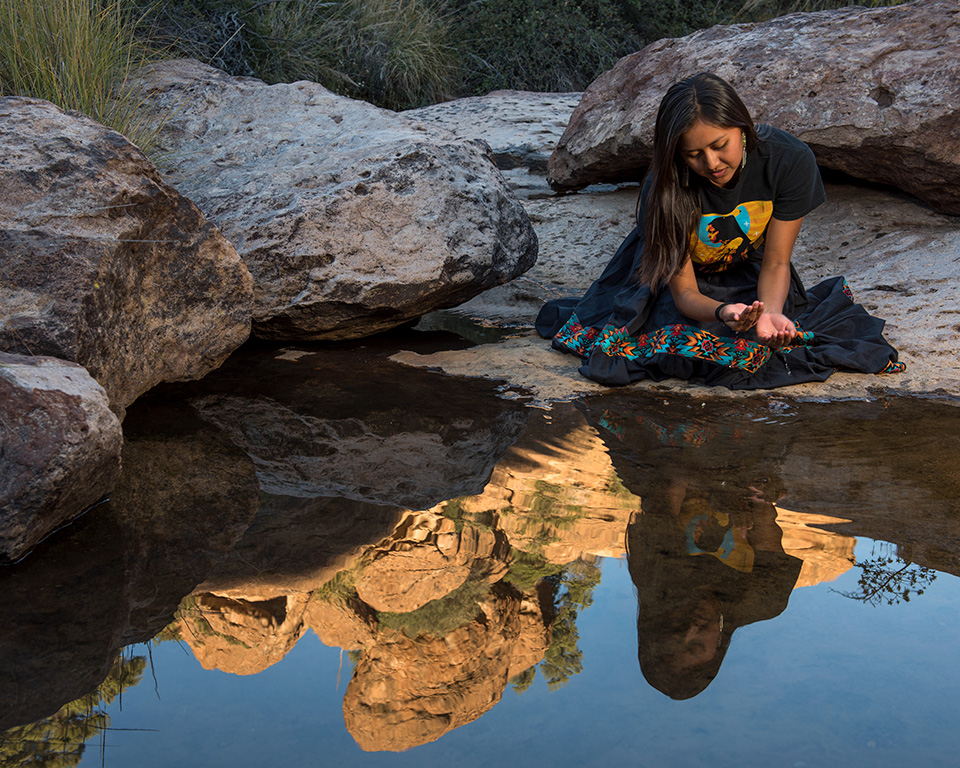
In their own language, the San Carlos Apaches are the Ndeh Nation. The tribe’s motto: “One People, One Nation.”
And in early February 2015, the people began a two-day, 44-mile journey from the tribal seat at San Carlos to Oak Flat Campground, near Superior, in protest of what former San Carlos Chairman Wendsler Nosie calls “the greatest sin of the world” — the December 2014 transfer of sacred tribal land to a foreign mining corporation.
At stake in the exchange is Oak Flat itself — the place where coming-of-age ceremonies for Apache girls are held, where medicinal herbs and acorns are gathered. Where, according to Nosie, his people received the blessings of the spirit.
I first visited Oak Flat years ago, drawn by the shadows of boulders — eroded faces of time and wind and sunlight. I pulled over, touched cool rock and watched the faces turn to spirits, noticed the pull of ore from earth nearby. I drove to the campground, all shady and tree-kissed and surrounded by boulders, and walked around. The world vibrated. Distant machinery, maybe. Or the mountains themselves, shaking and settling.
It is, as the legend goes, a place of light and dark. Of color and contrast.
“The mountain … is where God spoke to the world and blessed it with significant meaning through holy spirits,” Nosie says. “Our belief is that the Apache religion is just like any other religion. We believe it’s for everybody and every living thing that God created in this world.”
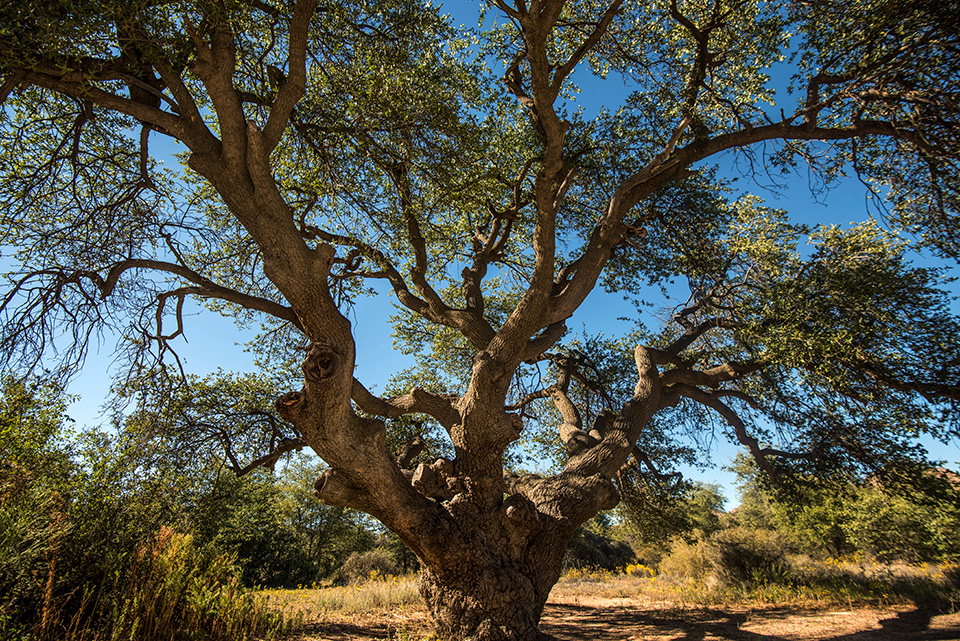
That’s why, to protect the place Nosie likens to Mount Sinai, the Ndeh became part of Apache Stronghold, a tribal community association, and the Occupy Oak Flat movement — they camp, educate visitors, march on Washington, D.C. And their voices were so loud, the National Park Service added Oak Flat Campground to the National Register of Historic Places. Although the move is symbolic and won’t affect the land transfer, it does recognize the historical significance of the area. Lawmakers also acquiesced on one other item — they released Apache Leap from the agreement.
At Apache Leap in 1870, a band of warriors jumped from a rocky outcropping, risking death by collision with the boulders below, rather than being overtaken by advancing soldiers led by General George Stoneman. The soldiers, part of the Arizona Military District, had raided an Apache village near Superior.
According to an article in the October 1940 issue of Arizona Highways: “A few miles east of Picket Post Butte at the upper end of the rolling desert valley of Queen Creek and close to the present-day mining camp of Superior rises another pile of rock called the Big Picacho. An impressive mass of rock whose steep walls have been gashed and eroded by time and the elements, it dominates the landscape. … When about two-thirds of the band had been killed or maimed by the hail of bullets fired at them, the remainder retreated in the only direction possible: toward the westerly edge of the mountain which, on that side, broke off abruptly into sheer cliffs, hundreds of feet high. Without a moment’s hesitation, the fleeing Apaches threw themselves over the towering cliffs in the faint hope of escaping fatal injury. But the leap into space was too great, and all those who sought that avenue of escape, were crushed and broken on the rocks below. … The decisive result of this fight broke forever the power of the Pinal Apaches in that region.”
That is, until the San Carlos Apaches stood in force against the land exchange. And for the people, it’s more than just a protest.
“It’s returning home,” Nosie says. “We’re finding the place we originated from and where all these holy gifts were given. When is it going to end? In the white perspective, they have the rules and regulations, and we don’t know when they’re going to enforce what they believe is right in terms of keeping the first people out. But for us, it’s home, and we intend to stay there forever and ever.”
An Act That Rocked the World
Section 3003 of the Carl Levin and Howard P. “Buck” McKeon National Defense Authorization Act (NDAA) for Fiscal Year 2015 appears on page 442 of the 698-page document. Titled “Southeast Arizona Land Exchange and Conservation,” its first clause lists the section’s purpose: “to authorize, direct, facilitate, and expedite the exchange of land between Resolution Copper and the United States.”
In 10 pages, the government of the United States of America transfers a 2,400-acre parcel of Oak Flat to Resolution Copper, a subsidiary of Rio Tinto, a multinational mining corporation headquartered in London.
The company’s plan, according to its website, is to pull ore from the deep veins of copper that run below Oak Flat’s surface as part of an extension of its existing mining operations in the region. “The project,” the site reads, “will generate sustainable benefits for Arizona, creating 3,700 jobs and $61.4 billion in economic value over the life of the mine.”
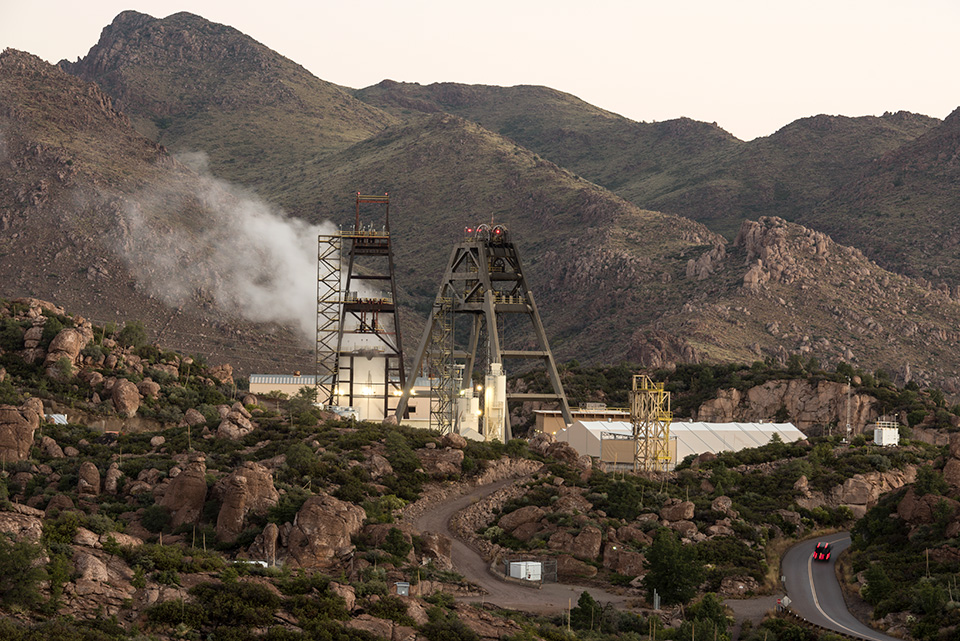
In exchange, Resolution Copper will convey 5,300 acres of conservation lands — lands considered highly valuable for their biodiversity, recreational opportunities and cultural significance — back to the United States. The biggest of those parcels is a 3,050-acre, 7-mile run of the San Pedro River where leopard frogs, turtles, and migratory and native songbirds thrive.
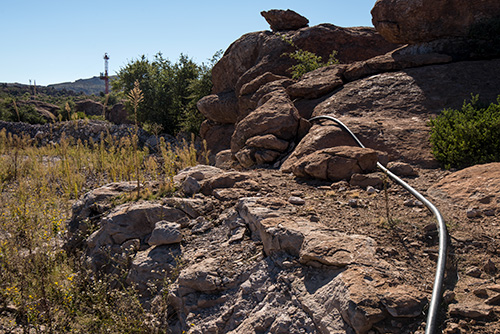
For the government and for the company, the exchange was balanced. But for the San Carlos Apaches, an array of environmental organizations and the rock climbers who consider Oak Flat one of the best recreational areas in Central Arizona, the legislation was a political maneuver fueled by financial promise and disregard for history, culture and the planet.
Indeed, Oak Flat’s history — the one outside of its centuries-old significance to the Apaches — is somewhat charming.
In 1955, President Dwight Eisenhower’s administration closed Oak Flat to mining under Public Land Order 1229. The story told locally is that Eisenhower and his wife, Mamie, picnicked under one of the area’s namesake oak trees, and Mamie, the story goes, was so moved by the beauty of the area that she pushed for its protection.
President Richard Nixon’s administration renewed the ban in 1971, and it lasted for decades. But in the early 2000s, lobbyists began pushing for land-exchange legislation in both houses of Congress. Since, several bills have been introduced in either the House or the Senate that would have transferred Oak Flat to Resolution Copper. None gained much traction — that is, until the entry in the NDAA.
Opponents of the exchange were quick to target Arizona Senators John McCain and Jeff Flake as the men behind the move. A May 29, 2015, op-ed in The New York Times noted that “Rio Tinto affiliates have been McCain campaign contributors, and that Mr. Flake, before he made it to Congress, was a paid lobbyist for Rio Tinto Rössing Uranium (a huge uranium mine in Namibia). Mr. McCain and others assert that the mining project will be a boost to the local economy, though it’s unclear how many of the 1,400 promised jobs would be local; a Superior-area miners’ group, in fact, opposes the swap on the basis that it won’t help the local people or economy. Rio Tinto, incidentally, has been called out in the past for environmental devastation.”
Despite three months of requests to his office, Senator McCain wouldn’t comment for this story. His press representative, however, did provide links to two items that state the senator’s official position on the issue. One, a post made to his Facebook page on August 27, 2015, states that the new mining efforts will create more than $61 billion in economic activity over the next 60 years, the equivalent, the post reads, “of Arizona hosting two Super Bowls every year for more than half a century.” The same post also rejects the commonly asserted argument that the exchange will affect tribal land or sacred sites. “There is no ‘Executive Order’ protecting Oak Flat,” the post adds.
“Desecration of one of these sites needs to carry the kind of offense that desecration to any other religious site — be it Christian, Muslim, Jewish — would carry.”
— Arizona Representative Raúl Grijalva
While Senator McCain was silent on the issue, Arizona Representative Ann Kirkpatrick, who’s trying to take Senator McCain’s seat in this year’s election and who also supports the exchange, did agree to an interview.
“I grew up in a small timber town in the White Mountains, and I’ve seen Arizona go through too many boom-and-bust cycles,” she says. “So my vision and my work are dedicated to creating a strong, diversified, stable economy. The Copper Corridor is part of that. It’s a century’s legacy of copper mining in that area. Generations of Arizona families have worked these mines, and they’ve been through some hard times. This is a spark plug for the local economy.”
While Representative Kirkpatrick acknowledges that not all of the jobs would be local, she says she believes small businesses will spring up in support of the new operation.
“All along, I’ve said this is just a spark plug,” she reiterates. “It’s up to the local people to build on that and diversify. … There has to be small businesses that come in for the long term.”
As for the San Carlos Apaches’ claim that Oak Flat is sacred land?
“I get that,” the congresswoman says. “I grew up with the Apaches, and I really understand that and have been very sensitive.” Apache Leap, she notes, has been removed from the exchange and is now protected by the Forest Service. “That will be permanent protection for their sacred site,” she says.
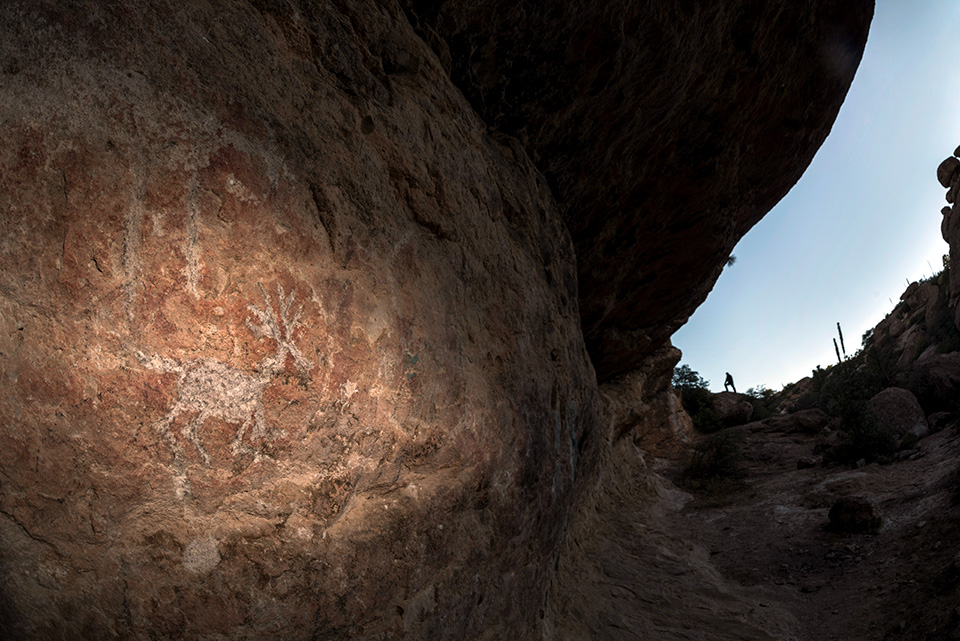
But it isn’t enough, according to Arizona Representative Raúl Grijalva.
I meet him in his Tucson office on a sunny November Monday. Somewhere, smoke curls toward the sky and smells like campfire — a little bit of wild tucked inside the city. As Representative Grijalva and I talk, he takes notes on a legal pad, sketching nonsensical shapes and patterns, reflections of the light pushing its way through the window, casting shadows into the corners of the room. His drawings are whimsy, but his policy is clear.
In the first session of the 114th Congress, the congressman introduced a bill that would repeal Section 3003 of the NDAA. It quickly became known as the Save Oak Flat Act and has since garnered bipartisan support, including co-sponsorship from Republican Representatives Tom Cole, Markwayne Mullin and Walter B. Jones. What’s more, presidential candidate and Vermont Senator Bernie Sanders introduced a companion bill in the Senate.
“What strikes me as particularly important is that there’s a lot of lip service paid to sovereignty and self-determination,” Representative Grijalva says. “That’s bipartisan lip service, so we have kind of a patronizing attitude about how we deal with [Native Americans]. … We need to recognize as a nation that this site carries not only spiritual significance to the Native people, but also a very important legacy for this country.”
He adds: “Desecration of one of these sites needs to carry the kind of offense that desecration to any other religious site — be it Christian, Muslim, Jewish — would carry. The next step is to recognize how these sites have helped define who we are as the West.”
Of Memory, Fear and Gravity
In his autobiography, Colonel W.F. Cody — better known to you and me as Buffalo Bill — wrote, “The West of the old times, with its strong characters, its stern battles and its tremendous stretches of loneliness, can never be blotted from my mind. Nor can it, I hope, be blotted from the memory of the American people, to whom it has become a priceless possession.”
The autobiography was published in 1920 — half a century after the Pinal Apaches jumped from Apache Leap, but long before Rio Tinto and other large mining companies took over the small copper claims of Western settlers. Prescient, perhaps, the quote is a reflection of what’s happening at Oak Flat today. Rock climbers and environmentalists fight to protect long stretches of loneliness, while the Apaches, politicians and company executives engage in a battle of philosophy and economics.
As it works to expand its operations, Resolution Copper plans to use a mining system known as panel caving. “The process begins with an initial round of explosives at the bottom of the ore body to break up the rock,” the company explains on its website. “Then rock is funneled downward and removed. The void created in the removal process allows gravity to continue forcing the ore body downward.”
But the problem, according to EarthWorks, a national nonprofit that works to provide communities with sustainable alternatives to mining, is the void that remains when all the ore is pulled from an area. It can’t be backfilled. The earth above the void collapses. A crater forms. And anything sacred or historic or beautiful is pulled into it.
Then there’s the issue of water. With an average annual rainfall of just 20 inches, the Superior area, according to the U.S. Drought Monitor, is in the midst of a “moderate drought.” Resolution Copper estimates that its panel caving technique will require 17,000 to 20,000 acre-feet of water each year, a projection that, so far, has prompted the company to begin purchasing Central Arizona Project water from two irrigation districts. One acre-foot of water is equivalent to 325,851 gallons.
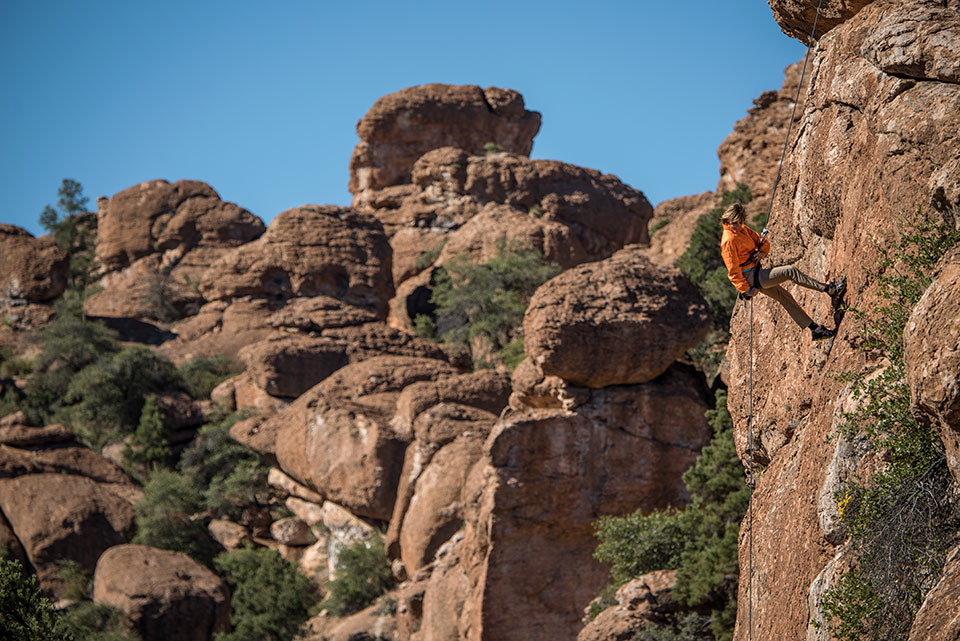
The mining equipment is quiet the day a handful of climbers drive me out to Magma Mine Road and walk me into Euro Dog Valley, a segment of Oak Flat known for its rock walls. It is late September, warm. The way it is when the season isn’t ready to change, but the people beg for it. Two mutts and a Portuguese water dog lead the way, scrambling up the trail and past thick clusters of agaves as though they’ve gone this way before. As the climbers drop their gear, I look up to meet Titanic Wall, the subject of this Sunday morning’s adventure.
The wall features routes rated between 5.7 and 5.11, meaningful among the people who speak that language — the rock climbers and boulder hoppers who flock to Oak Flat because of its ease of access from Phoenix.
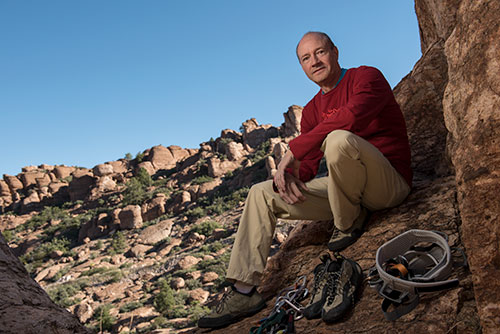
For me, Titanic is appropriately named. For the athletes who brought me here, it is an everyday, easy jaunt up slick-rock.
Ropes and harnesses. The dull, cool smell of chalk. I trade my Merrell boots for a pair of purple climbing shoes my sister gave me in exchange for something else — an old purse, maybe, or cowboy boots. Then I watch.
The climbers are up the wall in what feels like seconds, the arachnid extension of their legs so easy, the curl of their fingers into the creases of rock as natural as playing on piano keys. After an hour of watching, petting the dogs and swallowing my anxiety, I borrow a harness and have Curt Shannon tie me to a rope.
Shannon, a policy analyst for the Boulder, Colorado-based Access Fund, has climbed at Oak Flat for years. It’s just one reason he and his organization — which works to conserve climbing environments across the nation — have been vocal in their opposition to the exchange.
“The Access Fund has been involved in opposing the land exchange in its various forms since 2005, when the very first land exchange bills were introduced in Congress,” he says. “They were made aware of the issue by the local climbing groups.”
Much of what the Access Fund undertakes is public education. The other part? Direct lobbying on Capitol Hill.
“We try to point out all of the flaws and all of the reasons why having this mine is, on balance, not a good idea,” Shannon says. “Why the environmental damage, the loss of recreation, the pollution would far outweigh the benefits of the mine. … I’ve probably been back to Washington, D.C., 15 or 20 times over the past 12 years, specifically talking to the various agencies — the Department of Agriculture, the Department of the Interior, the administration, congressmen and their staffs. They’ve all been involved, in one way or another, in taking positions on the legislation, so we do try to influence them.”
Several superficial muscles comprise the anterior forearm, but the one that runs from the elbow to the base of the index finger is known as the flexor carpi radialis. It pulls blood from the radial artery and works to flex the hand. As I maneuver slowly and uncertainly up the wall, using a route I watched another climber master just minutes earlier, those muscles in both arms tense and freeze and relax again. My body shakes. Fear and gravity and fatigue, that extended flexion of the flexor carpi radialis muscles a new thing to me.
The thing about climbing — the thing I hadn’t considered before — is that, in addition to being a way to explore Arizona from a new perspective, it’s a way to empty your brain of clutter, to focus. Up. Survival. Down. Survival. It is problem-solving in its rawest form. And when you’re that close to the Earth itself, tied — quite literally — to the great rocks that rose from long-ago tectonic shifts, from the heating and cooling and passing of time, you begin to understand why places like Oak Flat are important, why it means something to protect them for future generations of climbers.
And while neither Shannon nor Representative Grijalva is overwhelmingly optimistic about the current legislation, they share a hope that by the time the mine completes the National Environmental Policy Act (NEPA) review process, there will be enough support on both sides of the congressional aisle to protect the land once and for all.
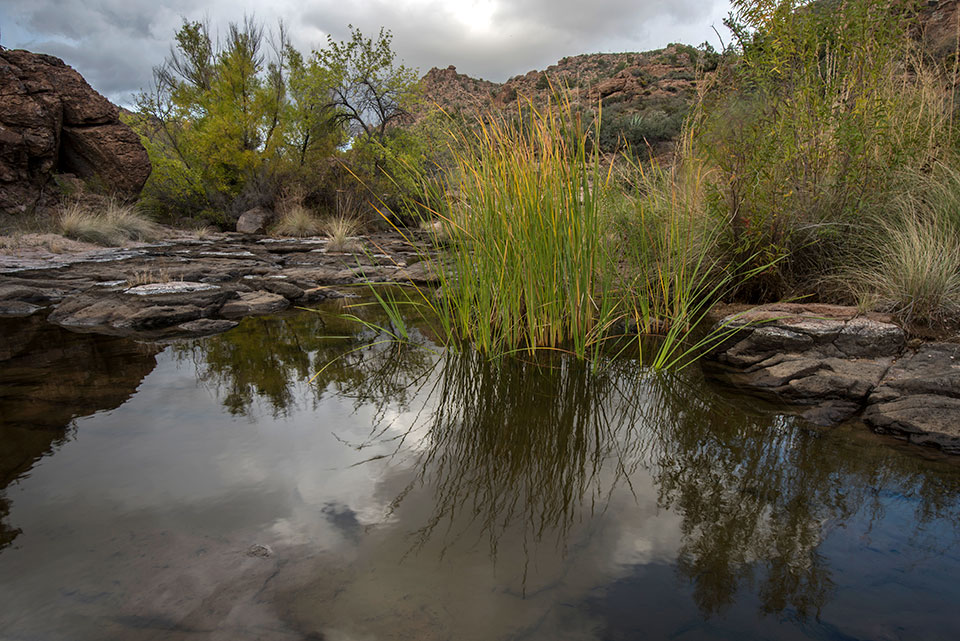
“We took a big hit when the land exchange bill was put into the [NDAA],” Shannon says. “Looking at the positive side, we’ll try to keep [the Save Oak Flat legislation] snowballing and gaining momentum, even though the bills might not pass in this Congress because of the current makeup of Congress. … The goal is to think a little bit more long term and to try to get it to pass before the land at Oak Flat is actually transferred to the mining company. We have several years to get that done, because of the NEPA process.”
In the meantime, the Access Fund will continue to educate the public about the environmental impact of the mine and what losing Oak Flat would mean to the climbing community.
“It’s an absolutely beautiful place, and it’s within an hour’s drive of Phoenix, which I think is one of the things that really makes it special,” Shannon says. “To say that the area could be replaced, which is what the mine says, is a little bit crazy. Sure, there are other beautiful places where people can climb — they exist already — but they’re not nearly as convenient to a lot of people. That will make them less used. There are people who would drive an hour to go out to Oak Flat for an afternoon, then drive back, but those same people wouldn’t drive two or three hours, then drive back.”
After successfully completing my first route up Titanic Wall, I try another. This time, though, I give up, unable to will my muscles to flex my hands anymore. I awkwardly scraped my legs against the rock during that first, slow climb, and blood runs like a snake from my shin into my shoe.
Months later, the scars from that wound and the deep scrapes on the insides of my knees have turned the same color as the rocks were that day at Titanic Wall, pink-brown and textured. And climbers are still traveling to Oak Flat as they await the NEPA report and the results of their efforts to repeal Section 3003 — at press time, more than 300 people had RSVP’d to the Queen Creek Boulder Comp, a climbing competition scheduled to take place at Oak Flat the first weekend in April.
But for the Apaches and the people who care about Oak Flat, the wound left by the NDAA is still wide open.
“We’re trying to undo a wrong,” Representative Grijalva says. “And that’s much harder than stopping a wrong.”

